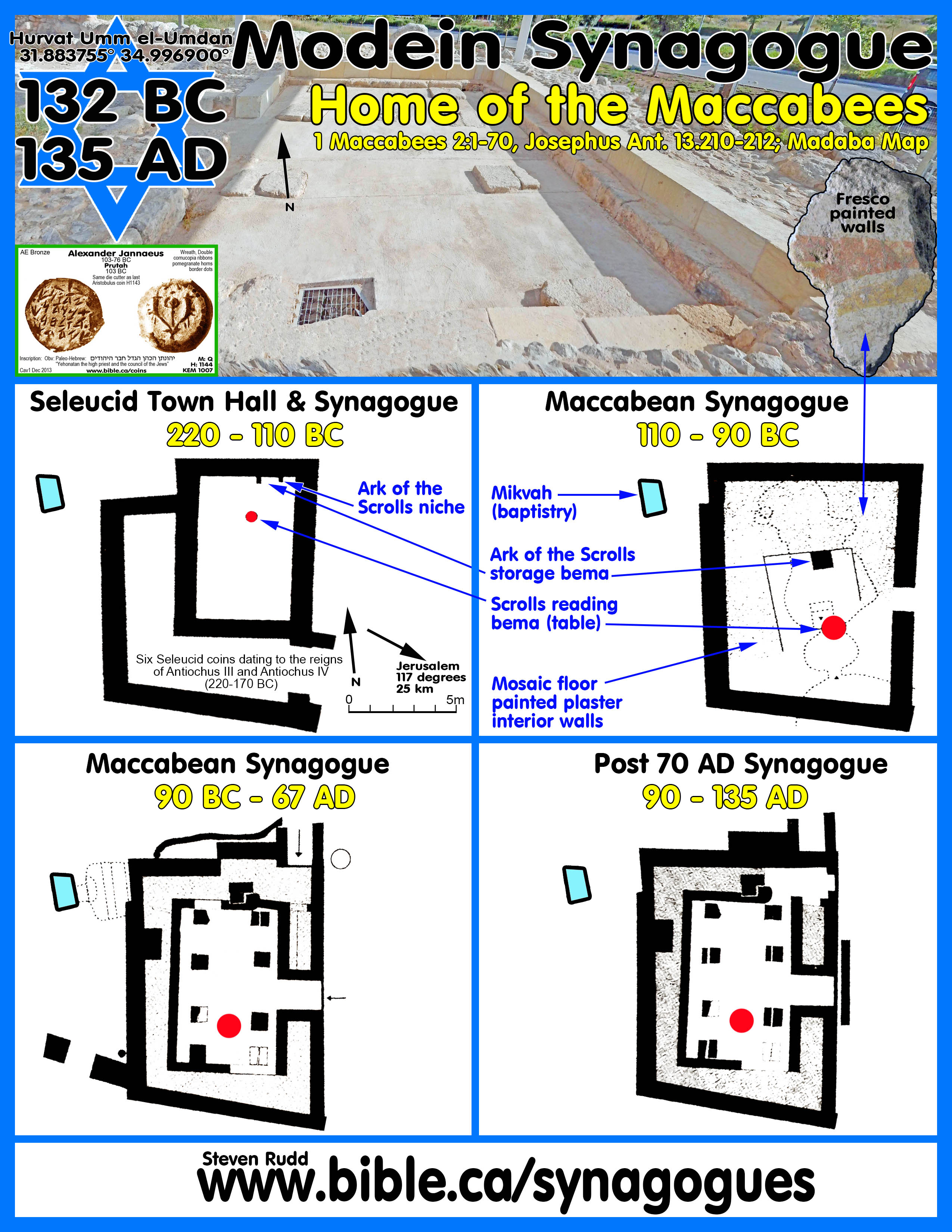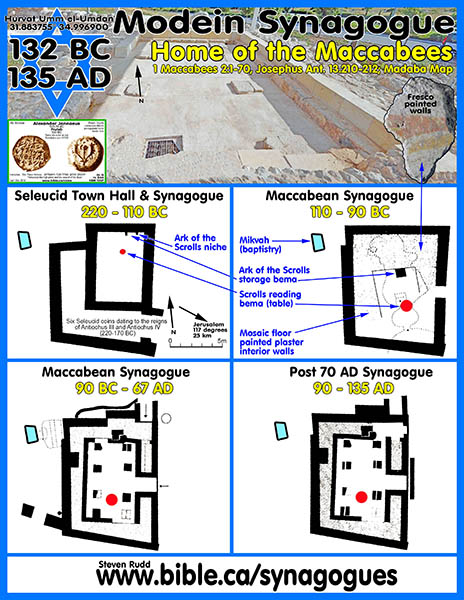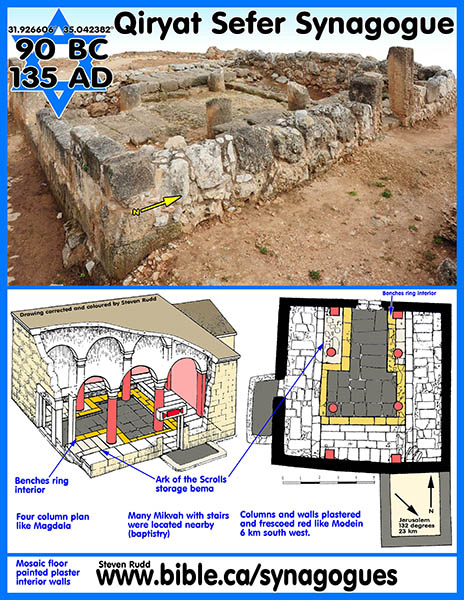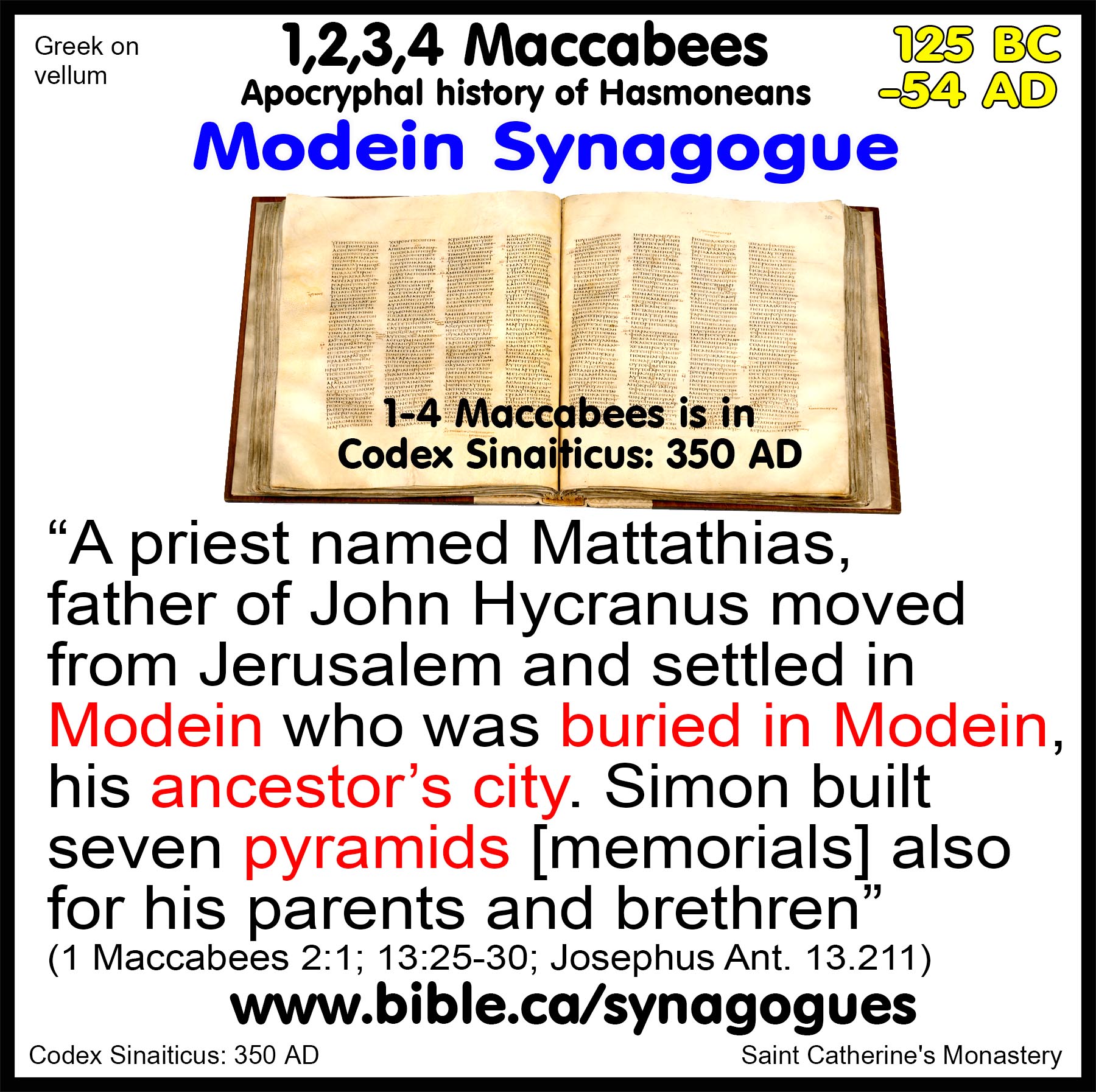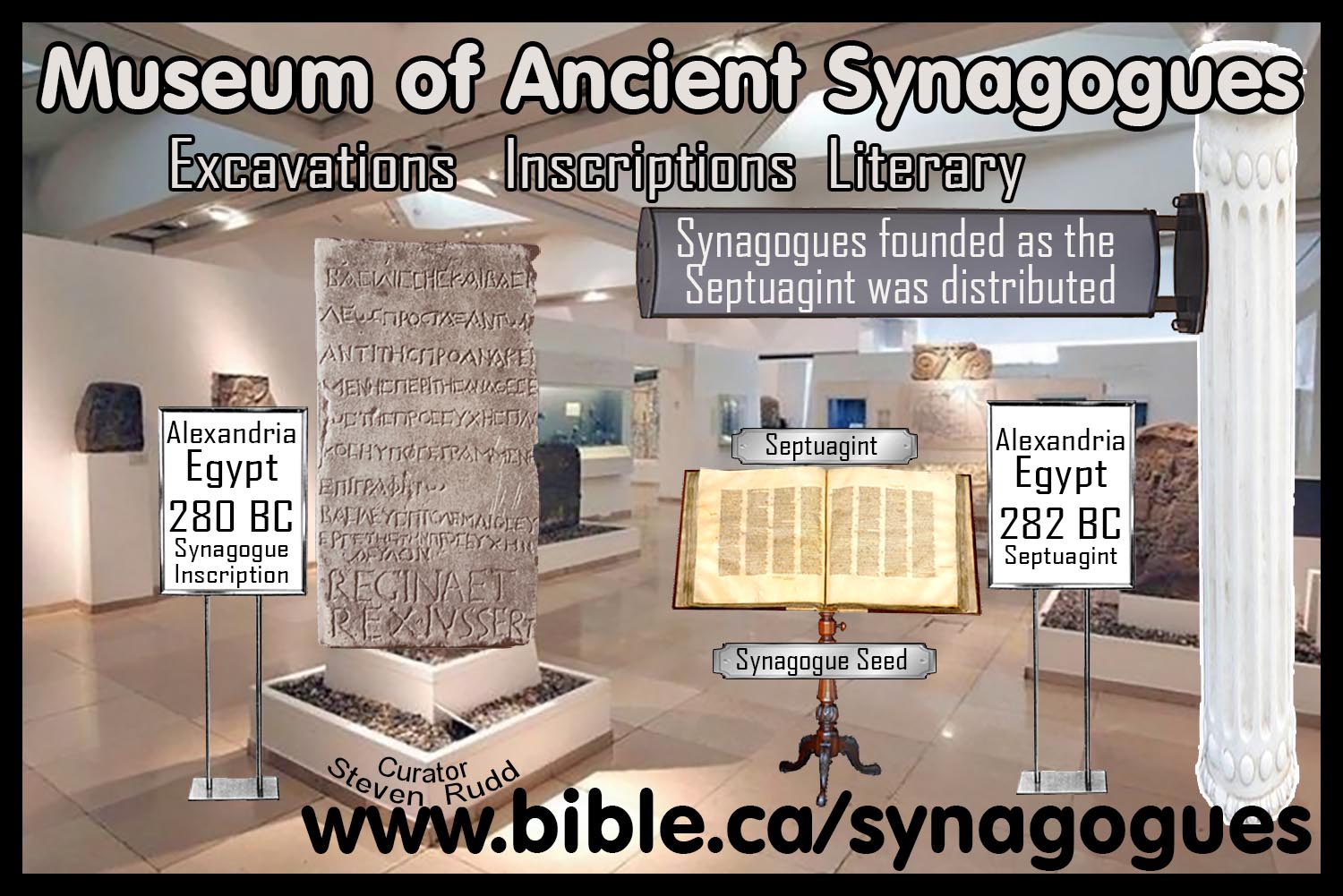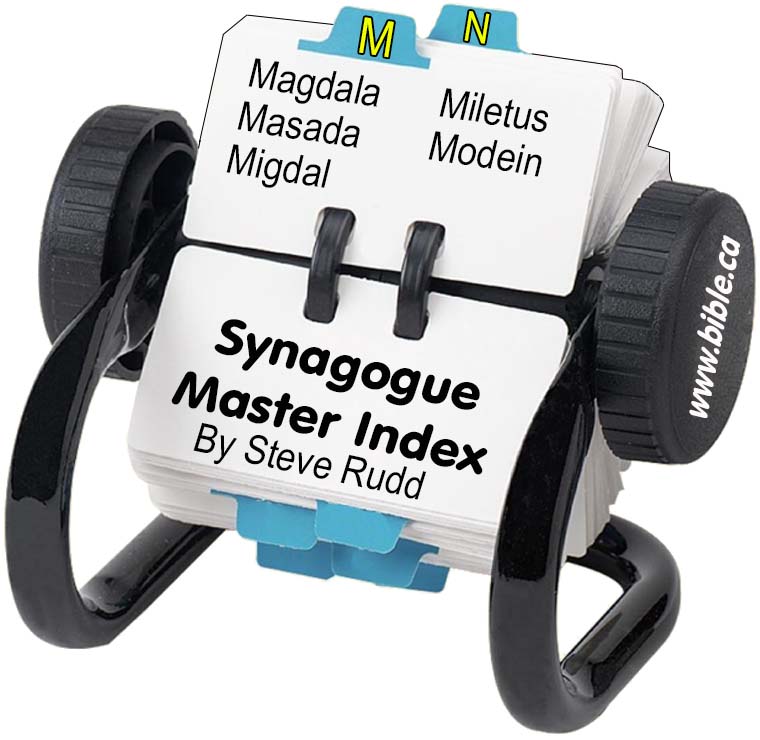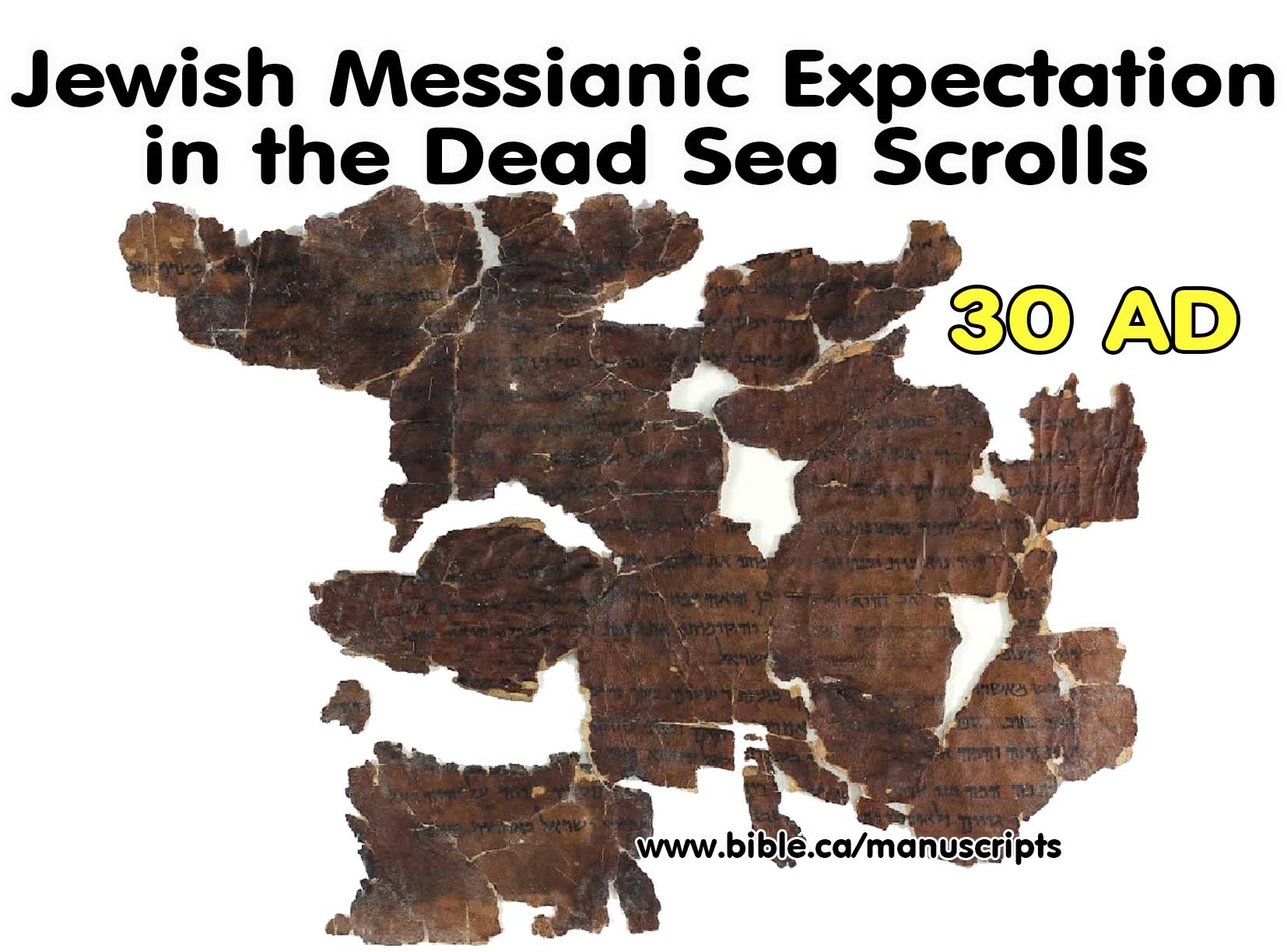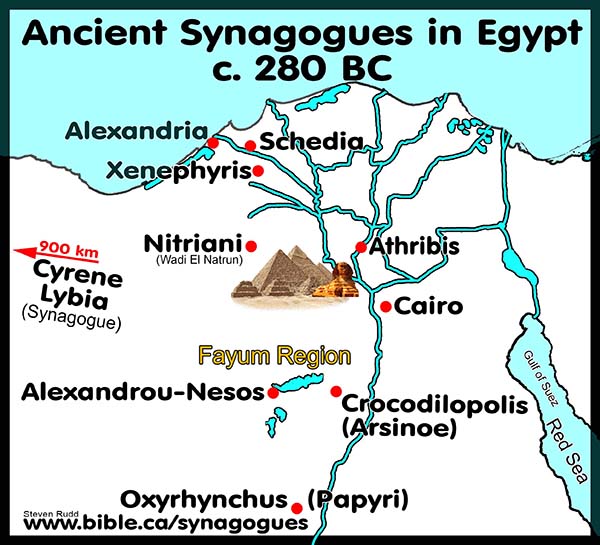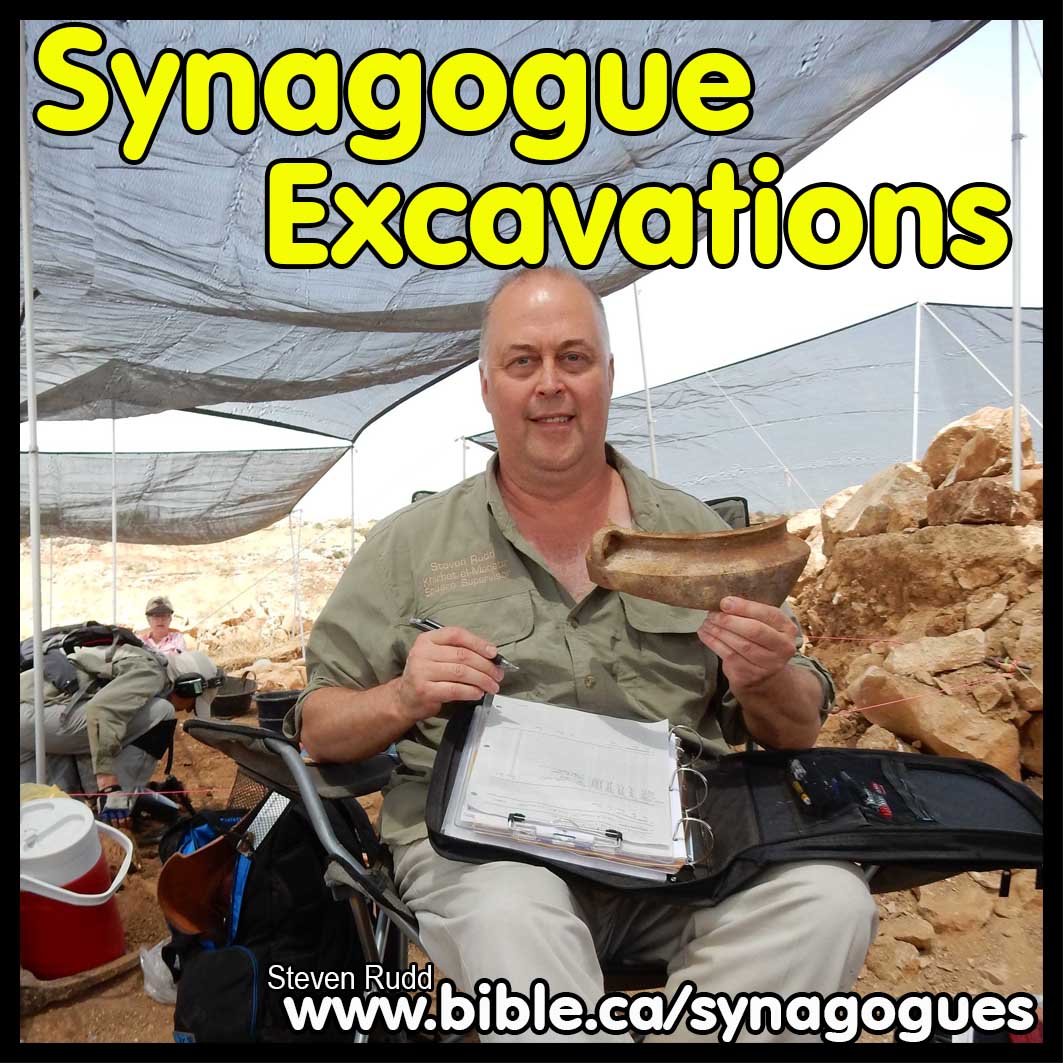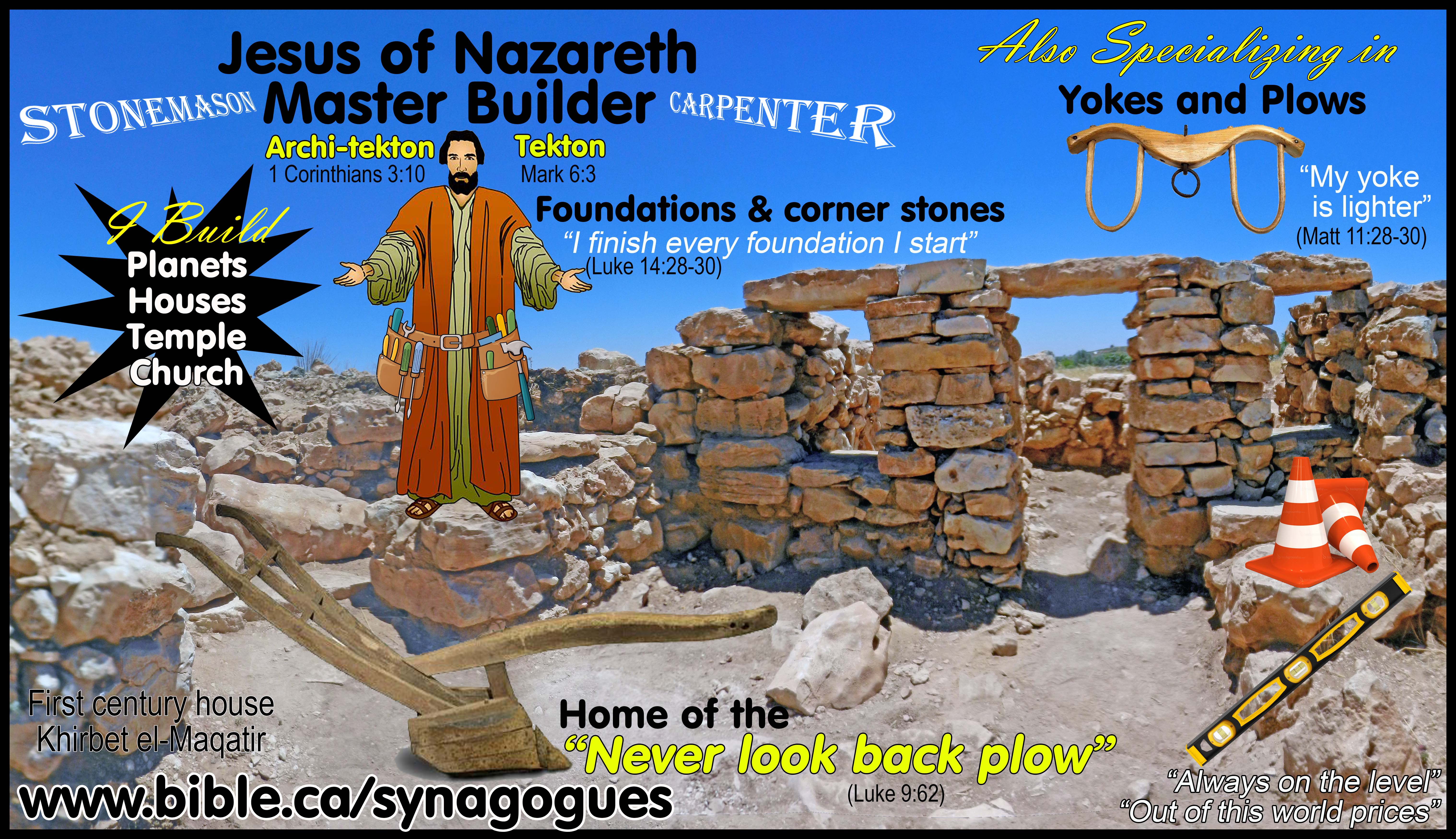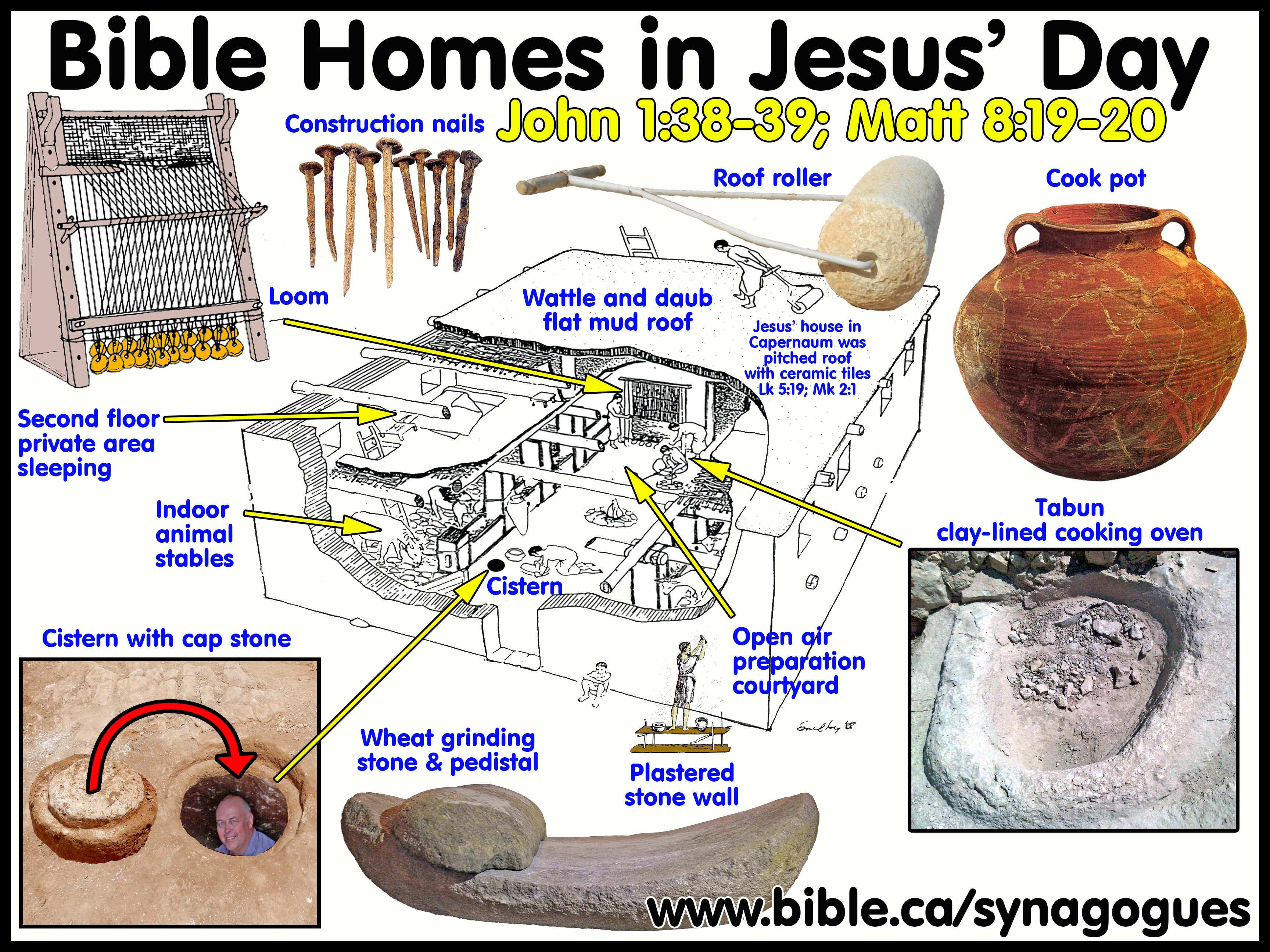First Century Synagogue Top Plans: Modein 132 BC
Archeological Excavations of Oldest Synagogues in the world
|
Modein 132 BC (Hurvat Umm el-Umdan) |
1. The Synagogue at Modein (Hurvat Umm el-Umdan)
a. GPS: 31.883755° 34.996900°
b. While there is no specific mention of a synagogue in 1st 2nd 3rd or 4th Maccabees one has been excavated.
c. Rectangular shape 12 x 10 meters, Bench seats. 8 interior pillars with a mikveh a few meters from the synagogue.
2. Modein is the hometown of Maccabees. (Hasmonean dynasty).
a. What 1st Maccabees does tell us in high detail, is that Modein was the home town of the Maccabees.
b. From Archeological excavation, we have uncovered a first century BC synagogue that was obviously built and used by the entire Hasmonean dynasty.
c.
The Maccabees put out a series of Jewish coins:
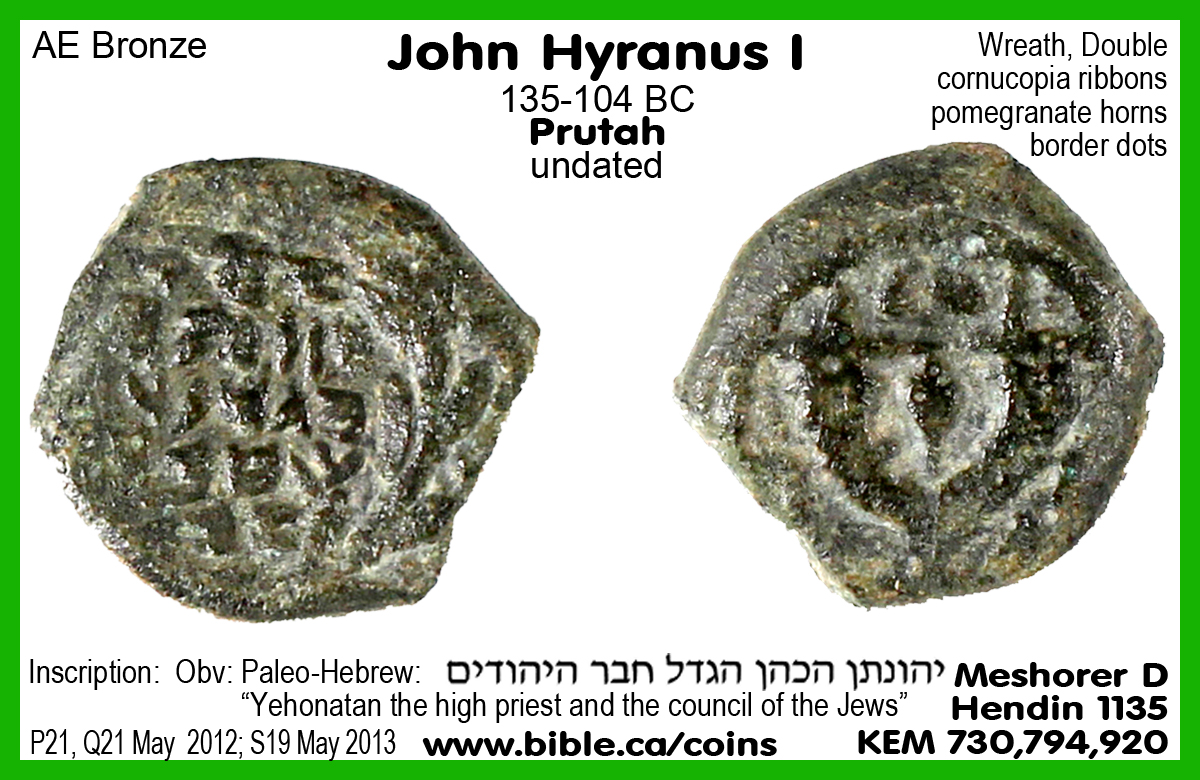
3. Modein is on the Madaba Map:
a. See also: The Madaba Map
b.
Modein is marked on the Madaba map, accompanied by the
legend in Greek: “Modeim, which today is Moditta, wherefrom were the
Maccabees.”
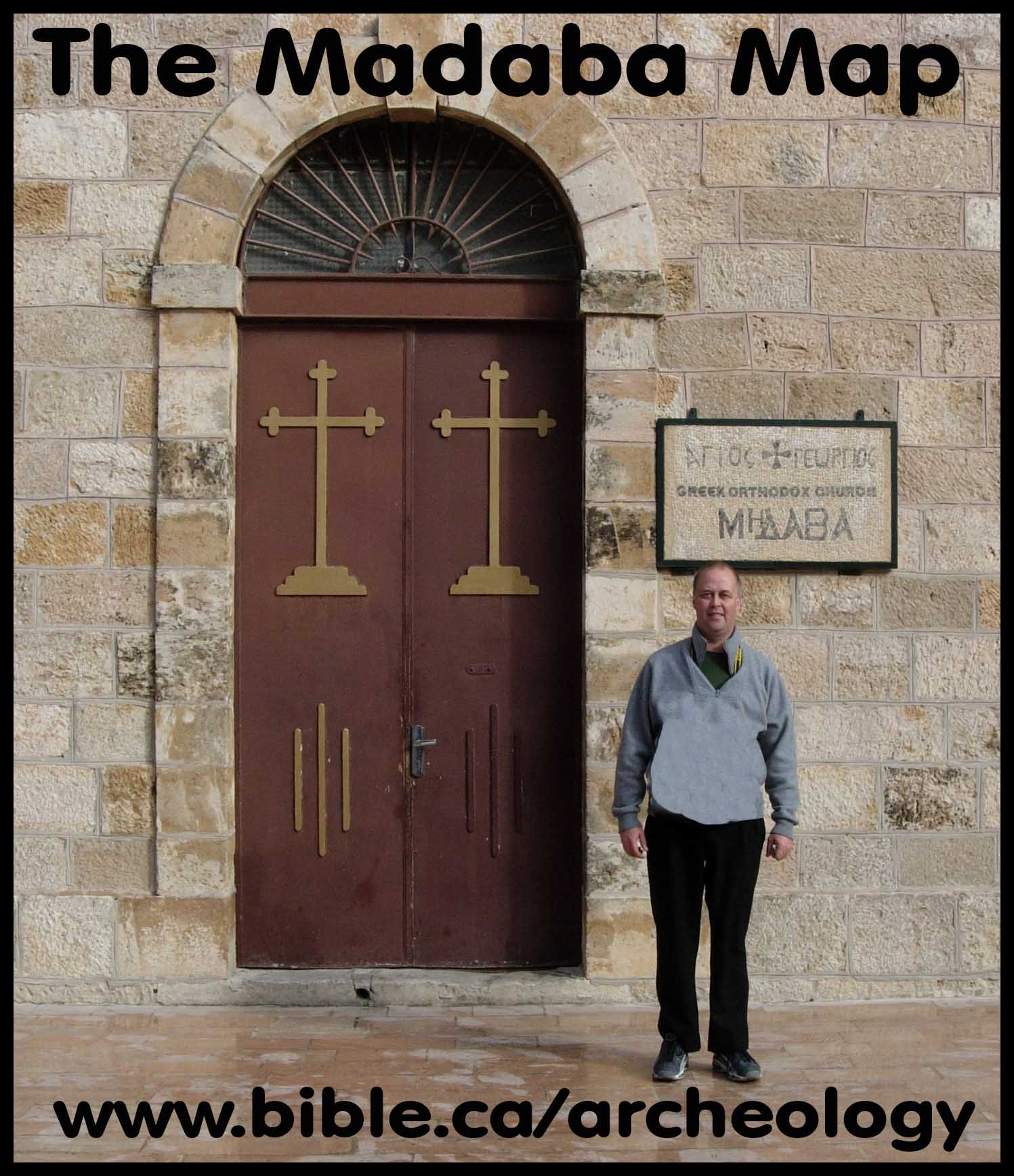
4. Twin synagogues of the Maccabees:
a. There is a second Maccabean synagogue at Kiryat Sefer a 6.5 km northwest of Modein that features the same red and yellow plaster fresco on the synagogue columns and wall.
b.
The columns at Magdala are also painted red.
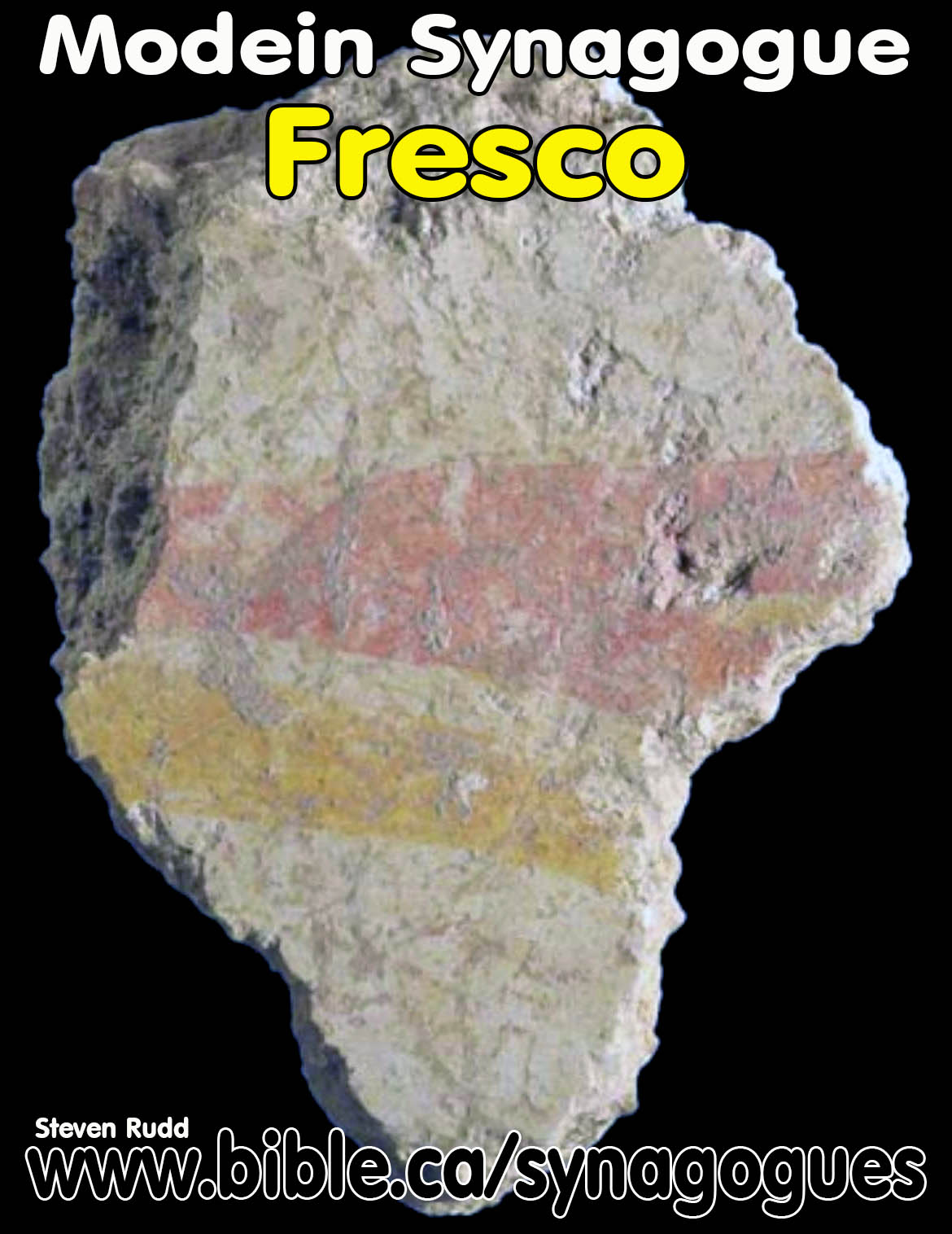
c. Likely both Modein and Kiryat Sefer were built and maintained by the Maccabees given their similarities in interior decorating.
A. Earliest Synagogue Occupation Date (SOD) = 132 BC
1. Excavation date: first century
2. Inscriptional date: none
3. Literary date:
4. SOD computation system details: Excavation date + Inscriptional date + Literary date = SOD.
B. Synagogue Compass Orientation:
1. Orientation East or towards Jerusalem: No.
2. Compass headings:
a. Compass heading towards Jerusalem: 117 Degrees.
b. Distance to Jerusalem: 25 Kilometers.
3. When an archeologist begins excavating a newly discovered synagogue, the first thing he does to determine if it is a first temple, pre-70 AD installation is determine the orientation.
a. If the synagogue points east it is not pre-70 AD but built after 200 AD.
b. If the synagogue is oriented towards Jerusalem it is not pre-70 AD but built after 200 AD.
4. See Orientation: Early Synagogues did not Point to Jerusalem
C. Bible and other Literary references:
1. The book of Maccabees provides a lot of information about Modein as the home town of the founders of the Maccabean movement known as the Hasmoneans.
a. “First Maccabees is a history of the rise of the Hasmonaean dynasty, from the daring deeds of the zealous priest Mattathias to the reign of John Hyrcanus” (AYBC, 1 Macc)
b. In chapter 2 of 1st Maccabees, an elderly priest named Mattathias is the father of five sons: John, Simon, Judas, Eleazar, and Jonathan.
c. Mattathias moves from Jerusalem to the village of Modein: 1 Macc 2:1-14.
d. Thus at the very beginning of the Hasmonean dynasty, Modein was the hometown of the entire Maccabean clan.
2. References in 1st Maccabees that Modein was the home town of the Hasmoneans:
a. "In those days rose up Mattathias [also spelled Mattithiah] son of John, the son of Simeon, a priest of the sons of Joiarib, from Jerusalem, and he settled in Modein." (1 Maccabees 2:1, 125 BC)
b. "And he said, “Woe is me! Why was I born to see this affliction of my people and the affliction of the city of the holy and to stay here during its being given into the hand of enemies, and the sanctuary into the hand of foreigners?" (1 Maccabees 2:7, 125 BC)
c. "And from the king came those who were enforcing the defection in the city of Modein, that they might sacrifice. And many from Israel came to them, and Mattathias and his sons were assembled together. And those from the king responded and said to Mattathias, saying, “You are a leader and honored and great in this city and supported with sons and brothers." (1 Maccabees 2:15–17, 125 BC)
d. "And he blessed them and joined with his ancestors. And he died in the one hundred and forty-sixth year, and his children buried him in his ancestors’ tombs in Modein, and all Israel mourned for him with great lamentation." (1 Maccabees 2:69–70, 125 BC)
e. "And as he finished speaking these words, a Judean man approached in the sight of everyone to burn incense upon the altar in Modein according to the command of the king. And Mattathias saw and grew zealous, and his insides trembled, and rage rose from judgment; and, rushing over, he killed him upon the altar. And the man from the king who had forced him to sacrifice, he killed at that moment and tore down the altar." (1 Maccabees 2:23–25, 125 BC)
f. "And John chose from the country twenty thousand males of war and cavalry, and they marched against Cendebeus and stayed at Modein." (1 Maccabees 16:4, 125 BC)
g. "And giving the outcome to the Lord of the universe, he exhorted those with him to fight to the death bravely for the laws, the temple, the city, their native land, and their way of life. And he set up the army near Modein." (2 Maccabees 13:14, 125 BC)
D. Occupation history:
1. Seven Pyramid Family Burial tombs in Modein of the Maccabees:
a. "This is the tomb that he (Simon) built in Modein; it is still there until this day." (1 Maccabees 13:30, 125 BC)
b. "And Jonathan and Simon lifted up Judas, their brother, and buried him in the tomb of their ancestors in Modein." (1 Maccabees 9:19, 125 BC)
c. "And Simon sent for and received the bones of Jonathan, his brother, and buried him in Modein, his ancestor’s city." (1 Maccabees 13:25, 125 BC)
d. JOSEPHUS: “However, Simon sent some to the city Basca to bring away his brother’s bones, and buried them in their own city Modin; and all the people made great lamentation over him. (211) Simon also erected a very large monument for his father and his brethren, of white and polished stone, and raised it a great height, and so as to be seen a long way off, and made cloisters about it, and set up pillars, which were of one stone apiece; a work it was wonderful to see. Moreover, he built seven pyramids also for his parents and brethren, one for each of them, which were made very surprising, both for their largeness and beauty, (212) and which have been preserved to this day; and we know that it was Simon who bestowed so much zeal about the burial of Jonathan, and the building of these monuments for his relations. Now Jonathan died when he had been high priest four years, and had been also the governor of his nation. And these were the circumstances that concerned his death.” (Josephus Antiquities 13.210-212, 125 BC)
E. Excavation details:
1. Mikveh for ritual purity:
a. See also: Mikveh for Ritual Purity: The Christian Maker
b.
There was a Mikveh nearby the synagogue
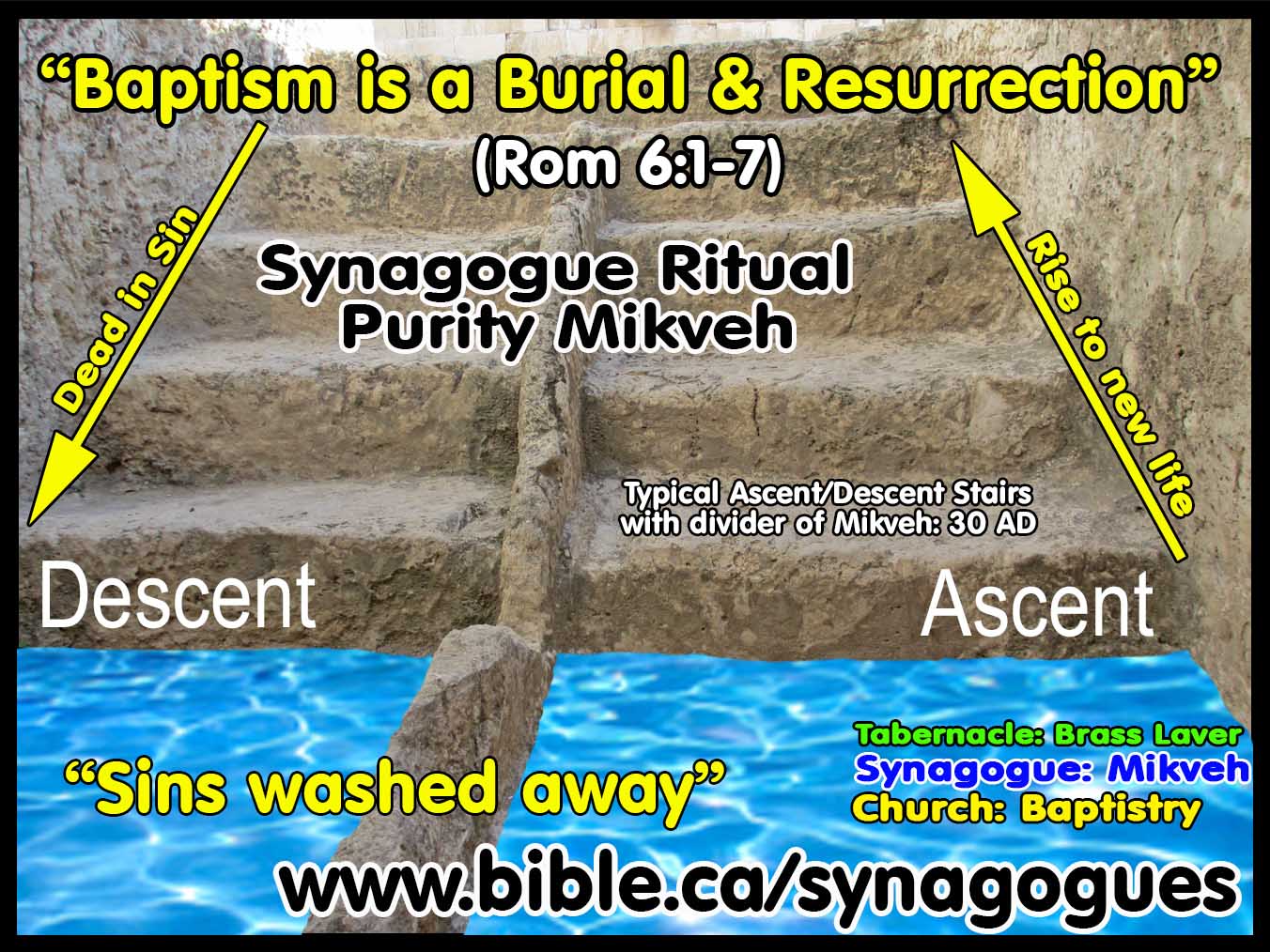
2. Synagogue columns:
a.
See also: Freestanding Columns: Antitype
of Christians and the church
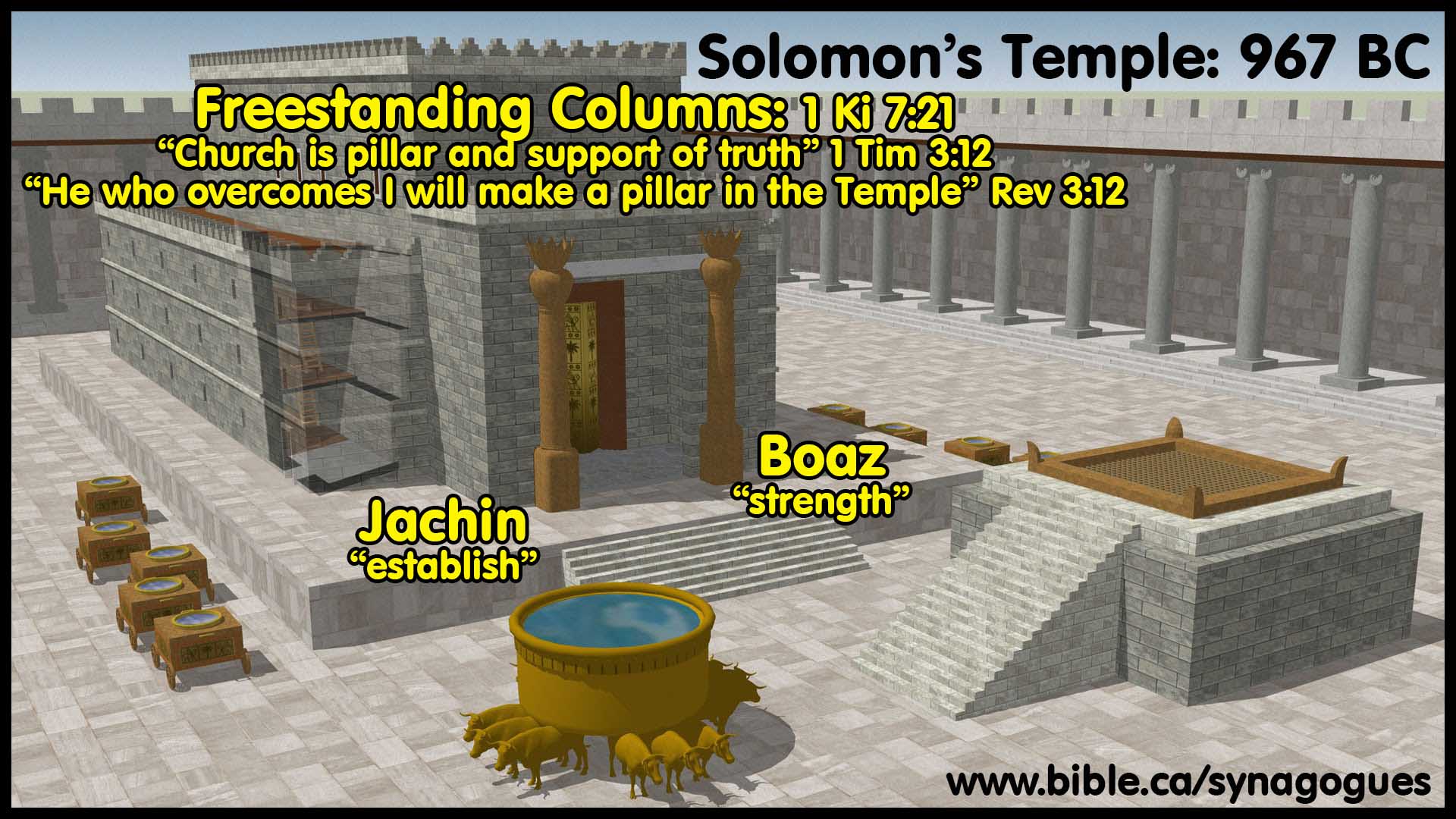
3. Synagogue bench seating
a. See also: Synagogue Benches: Metaphor of Equality in Christ
4. It had a niche for the Ark of the Scrolls wooden cabinet (Torah Shrine)
a. See also: Niches & Ark of The Scrolls: Prototype of Church Apse
b.
Pictured are various wooden Ark of the Scroll cabinets that would be
similar to the one at Modein.
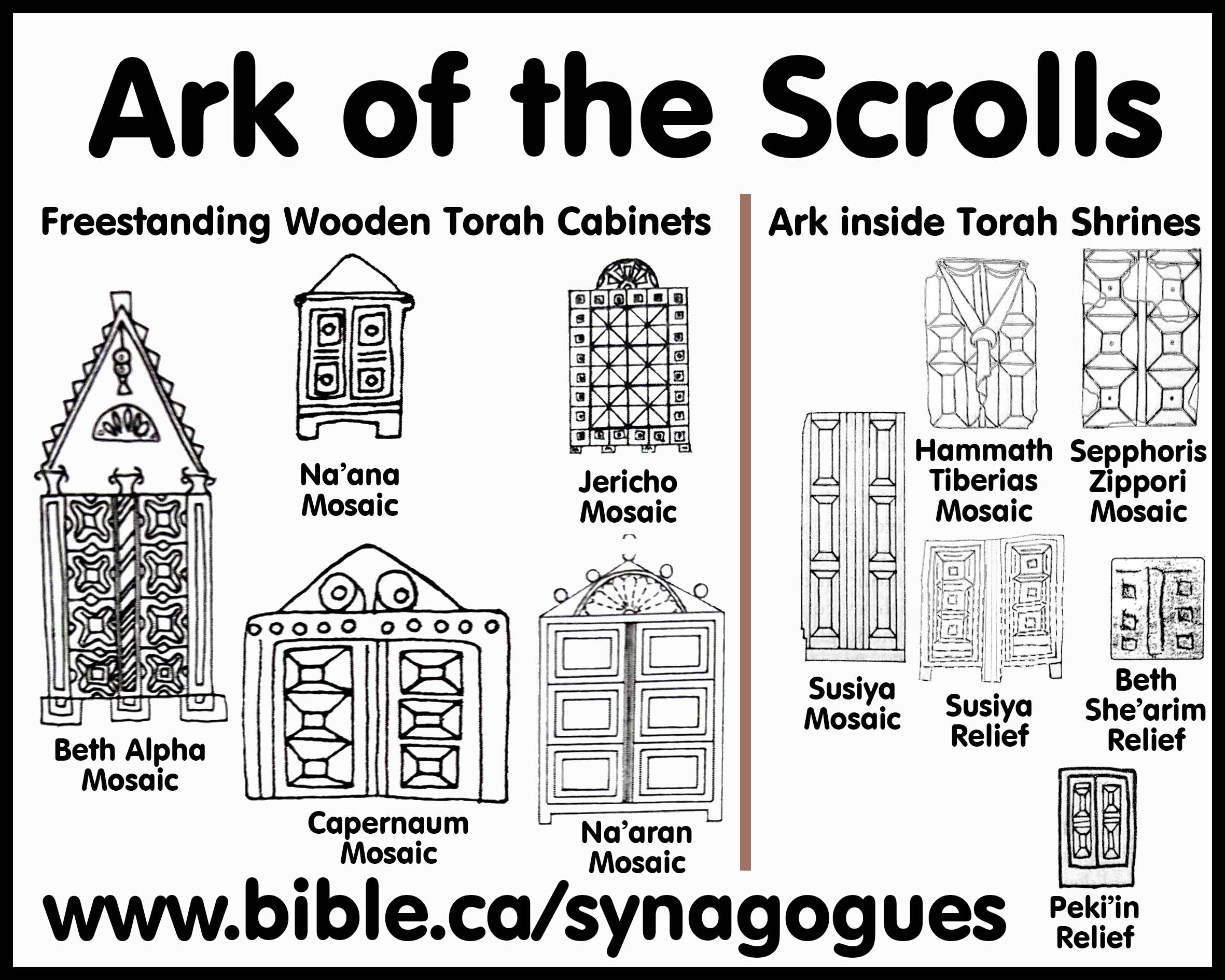
5. Bema and Table of the Scrolls:
a. See also: Table of the Scrolls: Prototype of Communion Table
b. See also: The bema: Prototype of the Church Pulpit
6. “Khirbet Umm el-Umdan is located on a hill to the north of the road joining Modi'in with the Latrun junction. The excavations revealed six main settlement strata from the Persian, Hellenistic, Roman, Byzantine, and Early Islamic periods. The main finds that were discovered - a rural settlement with a central lane flanked by residential structures and a public structure identified as a synagogue - date from the second century BCE to the Bar Kokhba rebellion (132 CE). The synagogue structure: a rectangular structure consisting of three rooms was built here in the Hasmonean period. A square (10 X 12 m.) building paved with stone slabs, and whose roof was supported by eight columns, was constructed over it in the time of Herod. The plan of the synagogue structure is similar to those of Second Temple period synagogues, such as those discovered at Masada, Herodium, and Gamla The ritual bath: a structure whose plan consists of a number of rooms and storerooms was excavated to the west of the synagogue, and a ritual bath was uncovered in one of the rooms. The structure shows signs of violent destruction. The bathhouse: an additional structure, of which only fragmentary remains were discovered, was identified as part of a Roman bathhouse.” (The Ancient Synagogue in Modi'in, Alexander Onn, Excavator)
7. “The Early Hellenistic Hall was only partially unearthed in the previous excavations, and its rectangular plan (3.8 × 7.0 m) was reconstructed on the basis of the wall and floor segments that were exposed. The entrance to the hall was apparently fixed in the center of the western wall. A narrow, L-shaped corridor leading to the opening was built around the southern and western sides of the hall. Six Seleucid coins dating to the reigns of Antiochus III and Antiochus IV (IAA 92217, 92223–92225, 92237, 92248) and fragments of pottery vessels ascribed to this period were discovered on the floors of the hall and of the courtyard and in the alley to their south; these finds provide a date for the hall’s use. The function of the hall at this time remains unknown; however, based on its plan—a single central space—it seems to have been a public building. This hypothesis is corroborated by the fact that public buildings, which we suggest were synagogues, were constructed directly over the Hellenistic hall. Evidently, the plan of the Hellenistic hall and its location in the settlement dictated the general shape of the synagogues that were constructed above it in later periods. In the current season of excavations, a hewn bedrock step was discovered in Sq 1350 (1 × 1 m), exactly where one entered from the courtyard into the peripheral entrance corridor. It seems that the rock-cut step marks the original entrance from the courtyard of the Early Hellenistic building to the peripheral corridor (Fig. 4: Sections 4–4, 5–5). In the Hasmonean period, a wall was built over the opening and blocked it (W289; Fig. 6), and was later integrated in the Herodian synagogue’s eastern bench (below). The Hasmonean Synagogue (Fig. 7). A slightly larger structure (6.7 × 10.5–11.5 m), identified as a synagogue, was built in the Hasmonean period above the Early Hellenistic hall and its peripheral corridor. The hall’s entrance was fixed in the middle of its eastern wall. A U-shaped array of benches ran the length of three of the walls, although not parallel to them. The many fragments of red, yellow and white plaster discovered in the previous excavation above the floor of the hall indicate that the walls were decorated with colorful frescoes. The frescoes were painted in the secco technique, and were dated according to their style to the Hasmonean–Herodian periods (the first century BCE, prior to the year 15 BCE). Similar wall paintings were found in Jericho, Jerusalem and elsewhere (the frescoes were studied and identified by Dr. Sylvia Rosenberg, and they will be published in the final excavation report). The date of the hall was determined on the basis of five Hasmonean coins from the time of John Hyrcanus and Alexander Jannaeus, which were discovered in the hall in the past (IAA 92213, 92227, 92233, 92235, 92421), and numerous fragments of pottery vessels from the Hellenistic–Hasmonean periods. An additional, ex-situ coin (Basket 13023; IAA 143558) that belongs to this phase was discovered during the current excavation season inside the synagogue hall, on top of the built bench from the Herodian period (below). The current excavation exposed the outer courses of the outer walls of the Hasmonean hall, which were built of large, fairly coarse and only partially hewn stones (Fig. 8); they continued to be used in the Herodian structure. In the conservation work that preceded the excavation, a fragment of a fresco made in the secco technique (Fig. 9) was discovered in the synagogue. Its style is similar to that of a group of wall-painting fragments that were discovered in the past above the floor of the Hasmonean phase, and probably originated from the walls of the hall. A tamped-earth floor (L1302; Fig. 10) that belongs to either the courtyard of the Early Hellenistic hall or to the courtyard of the Hasmonean synagogue was exposed in Sq 1300 (1.2 × 1.7 m). In the west, the floor was integrated with stones (L1303), but since only a limited area was exposed it could not be determine whether these stones, which protruded to a higher elevation than that of the preserved floor, were part of the floor foundation, severed it or belonged to W110. A jar with an everted and folded rim that dates to the Hellenistic/Hasmonean period (Fig. 11:1) was discovered among the stones of L1303, and it therefore appears that Floor 1302 and Stone Heap 1303 belong to the courtyard of the Hellenistic or the Hasmonean hall, prior to enlarging the structure during the Herodian period. A fragment of a bowl with a thickened rim, dating to the Hellenistic/Hasmonean period (Fig. 11:2), and fragments of two bag-shaped jars with upright necks and straight or thickened rims of the type common in the Herodian period (Fig. 11:3, 4) were discovered in the fill (L1301) above Floor 1302. The Herodian Period. During Herod’s reign, a new, broader hall was constructed over the Hasmonean synagogue. The Herodian hall (8.6 × 10.5–11.5 m; Fig. 12) utilized the northern, western and southern walls of the Hasmonean hall, while a new wall (W200) was built in the east, parallel to the eastern wall of the Hasmonean hall and c. 1.7 m to its east. The main entrance to the hall was incorporated in the center of the eastern wall, and another opening was fixed in the northern wall, near the hall’s northwestern corner. The hall during this phase was characterized by two rows of four columns each (Fig. 3: P1–P8) and two or three stepped benches (overall width c. 1.7 m) that encompassed the hall on all four sides and were built parallel to its walls. The core of the benches (L1401) was built of medium-sized fieldstones arranged one next to the other, with only earth between them and no mortar (Fig. 13). The floor of the hall was made of tamped earth, and in a later phase, probably in the early first century CE, a new plaster floor was installed above it that extended up onto the benches. The similarity of the Herodian hall to the Hasmonean hall on the one hand and to buildings identified as synagogues at Masada, Herodium, Gamla, Migdal and Kiryat Sefer on the other, allow us to conclude with a measure of certainty that the Herodian structure is a synagogue. During the current excavation, the core of the Herodian benches (L1401) was dismantled in the southwestern corner of the hall (Sq 1400; 1 × 1 m), and the excavation continued into soil fill that contained fieldstones (L1402; Fig. 14). While taking apart the core of the benches, a Hasmonean coin of the Palm-Branch Type (Basket 13023; IAA 143558; identified by D.T. Ariel) was found between the stones at the top of the bench. The worn condition of the coin does not allow us to identify whether it was minted during the reign of John Hyrcanus or of Alexander Jannaeus, and is therefore dated between 129 and 76 BCE. The pottery sherds recovered from the core of the benches included jar fragments, the most common of which were bag-shaped jars with upright necks and a variety of rims—plain, thickened with a triangular cross-section, or collared—typical of the first century BCE (Fig. 15:1–8). Some of the jars have a slight ridge at the base of the neck. Among the other ceramic finds were a cooking pot with an upright neck and a thickened rim (Fig. 15:9); a thin-walled jug with a rim that widens outward (Fig. 15:10); a large utility jug with a broad neck, a short, everted rim and a handle drawn from the rim to the shoulder (Fig. 15:11); and an amphoriskos with a cup-like rim and a slightly twisted handle (Fig. 15:12). These vessels are typical of the first century BCE—the Hasmonean period and the time of Herod’s reign. A base ring of a bowl, red-slipped both inside and outside (Fig. 15:13), which possibly dates to an earlier period, and a fragment of a basalt grindstone (Fig. 15:14) were also found. The finds recovered from the soil and stone fill below the core of the bench (L1402) include a large bowl with a thickened rim from the Hellenistic period (Fig. 16:1), a cooking pot with a high neck characteristic of the Hasmonean period (Fig. 16:2), bag-shaped jars similar to those discovered in the core of the bench (Fig. 16:3, 4) and a stone bowl decorated with incisions (Fig. 16:5). In Sq 1450 (1 × 2 m), the northwestern square, a row of stones (L1451) that was used to thicken the inside corner of the hall (W49, W50) was dismantled, exposing the walls of the hall, which were built of large, coarse rocks (Figs. 3: Sections 1–1; 17). The excavation reached down to the bedrock in the corner of the hall. The soil fill that was excavated was not sealed by the core of the bench, as it was not preserved there. In the soil and stone fill below the wall addition (L1451) were a jar typical of the Hellenistic/Hasmonean period (second–first century BCE; Fig. 18:2), a bag-shaped jar with a high neck and a plain rim characteristic of the Herodian period (Fig. 18:3), and a jug with a rim that widens toward the outside and a handle drawn from the rim to the shoulder, which was common in the Hasmonean period (second–first century BCE; Fig. 18:4). An ash level covering the bedrock, the nature of which was not ascertained (possibly an installation; L1452), included a fragment of a hemispheric bowl common in the second–first century BCE (Fig. 18:1). The excavation below the benches in the corners of the hall revealed the lower courses of the synagogue’s outer walls, which were previously unknown. The synagogue walls were built of large, partially hewn, coarse boulders placed on top of each other in dry construction (the mortar might have been washed away in the past). Small fieldstones were placed between the larger stones in order to level the courses. The ceramic finds discovered when dismantling the core of the benches in the southwestern corner of the Herodian hall (L1401, L1402) indicate that the benches were built in the first century BCE. The finds confirm the conclusions drawn after the previous excavation, according to which the synagogue hall with the row of columns running its length and the stepped benches along its walls dates to the reign of Herod (the second half of the first century BCE). Meager remains of earlier floors and installations (L1302, L1303 in the northeastern square and L1452 in the northwestern square) were dated to the Hellenistic–Hasmonean periods (second–first centuries BCE) and they belong to earlier phases of the hall—the Hasmonean and the Early Hellenistic phases; however, it is impossible to identify their exact nature. (Modein, IAA excavation report, Shlomit Weksler-Bdolah, 2014 AD)
8. “Modiin—Hurvat Umm el-Umdan: A public structure discovered at Modiin—Hurvat Umm el-Umdan has been identified as a Second Temple period synagogue (Onn, Weksler-Bdolah and Rapuano 2004; Onn and Weksler-Bdolah 2005). The original Hellenistic structure—the Seleucid hall (stage 1, end of 3rd-early 2nd centuries BCE) was a rectangular building (7.00 x 3.80 m) with an entrance on the western wall and was probably not a synagogue. Above this first structure, a public building with three stages was constructed (Figs. II-1f, 11-9). “Synagogue I (Stage 2): The earliest synagogue was built above the Hellenistic structure and has been dated to the end of the 2nd—late 1st centuries BCE (the Hasmonean period). The public structure, which contains a trapeze-shaped hall (10.5 x 6.7 m) surrounded by a courtyard, used parts of the earlier structure it was built on. The entrance to the structure was in the center of the east wall. Wide benches (or a basis for them) were attached to three of the walls. The walls were decorated with colored wall paintings. Two fixtures were found in the center of the hall, one a square bimah (1.1 x 1.1 m) and the other a round base? In the courtyard a sort of sitting bath was found. Synagogue II (Stage 3): The Herodian synagogue (11.5-10.5 x 8.6 m) was built above the earlier, destroyed structure in the late 1st century BCE. The main entrance to the structure was in the center of the eastern wall and there was another entrance on the northern wall. The hall was divided by two rows of four columns each, of which the stone bases survived; the columns were added to hold the roof or another storey. Benches surrounded the hall on four sides; the center of the north bench was pronounced (perhaps a special seat). The floor was plastered and the same round fixture was in use in this stage also. The courtyard floor on the east was plastered and a bench was built along three walls, with the sitting bath still in use. In the courtyard west of the synagogue, a two-room mikveh was found. Synagogue III (Stage 4): The synagogue was reconstructed at the end of the 1st or beginning of the 2nd c. CE, perhaps even in the 3rd. The entrance on the northern wall was closed, another entrance was opened at the north part of the eastern wall, and a new plastered floor was set. The plan of the structure in all its stages is characterized by the benches built along the walls, which indicates the importance of the hall's center with its fixtures and identifies it as a synagogue; it also provides proof for the existence of synagogues in villages as early as the Hasmonean period. ” (Ancient Synagogues - Archaeology and Art: New Discoveries and Current Research, Rachel Hachlili, p34, 2013 AD)
9. “Discovered in excavations undertaken in 2000-2001 by A. Onn and others, this village existed from the Persian period onwards, with the main stratum dating from the Roman era. Residential homes, alleys, a migveh, and remnants of a bath were found, in addition to a public building identified as a synagogue. The earlier phase of this building, a well-built rectangular structure (6.5 by 11 meters), with a flagstone floor, benches, and fresco remains, dates from the Hasmonean era and may have served as a synagogue as well. The building's second and main phase dates from the Herodian period and continued to the Bar-Kokhba revolt (132-135 C.E.).” (The Ancient Synagogue, Lee Levine, p70, 1999 AD)
10. This building was discovered during excavations of the village of Modi’in by Alexander Onn in 2000-2001. The village dates back to the Persian period, but most of the remains come from the Roman era. Among the discoveries found were a miqweh, a bathhouse, and a public building identified as a synagogue. The original building (11 x 6.5 m) dates back to the Hasmonean period, and the edifice may have served as a synagogue already at that time (so Levine,Thut cf. Onn et al., p. 66). It had a rectangular niche in the northern wall. The second and principle phase dates to the Herodian period. The main hall measures ca. 12 x 10 m and had a floor paved with stone. Benches lined all walls, and eight columns in two rows (four each) supported the roof. Fragments of red, white and yellow painted plaster (secco), dated to the first century B.C.E., were found. Alterations were made in the building in the firstThe century; this third phase of the edifice ended during the Bar Kochba revolt when the building was destroyed. A small room (2.3 x 2 m) was located to the northeast of the main hall, with a passageway connecting the structures. Levine notes that this synagogue is among the oldest discovered in Judaea so far, dating from about the same period as the Gamla synagogue and the early edifice mentioned in the Theodotos inscription. (The Ancient Synagogue from its Origins to 200 AD, Anders Runesson, p57, 2008 AD)
Conclusion:
1. The town of Modein has a long and rich history in Jewish life, given it is the birthplace of the Maccabees.
2. The synagogue that was excavated was in use by the Maccabees as far back as 132 BC.
3. See also: First Century Jewish Messianic Expectation: As witnessed in the Dead Sea scrolls.
By Steve Rudd 2017: Contact the author for comments, input or corrections
|
Jesus your messiah is waiting for you to come home! |
|
|
Why not worship with a first century New Testament church near you, that has the same look and feel as the Jewish Synagogue in your own home town. As a Jew, you will find the transition as easy today as it was for the tens of thousands of your forefathers living in Jerusalem 2000 years ago when they believed in Jesus the Nazarene (the branch) as their messiah. It’s time to come home! |
|
By Steve Rudd: Contact the author for comments, input or corrections.
Go to: Main Ancient Synagogue Start Page
